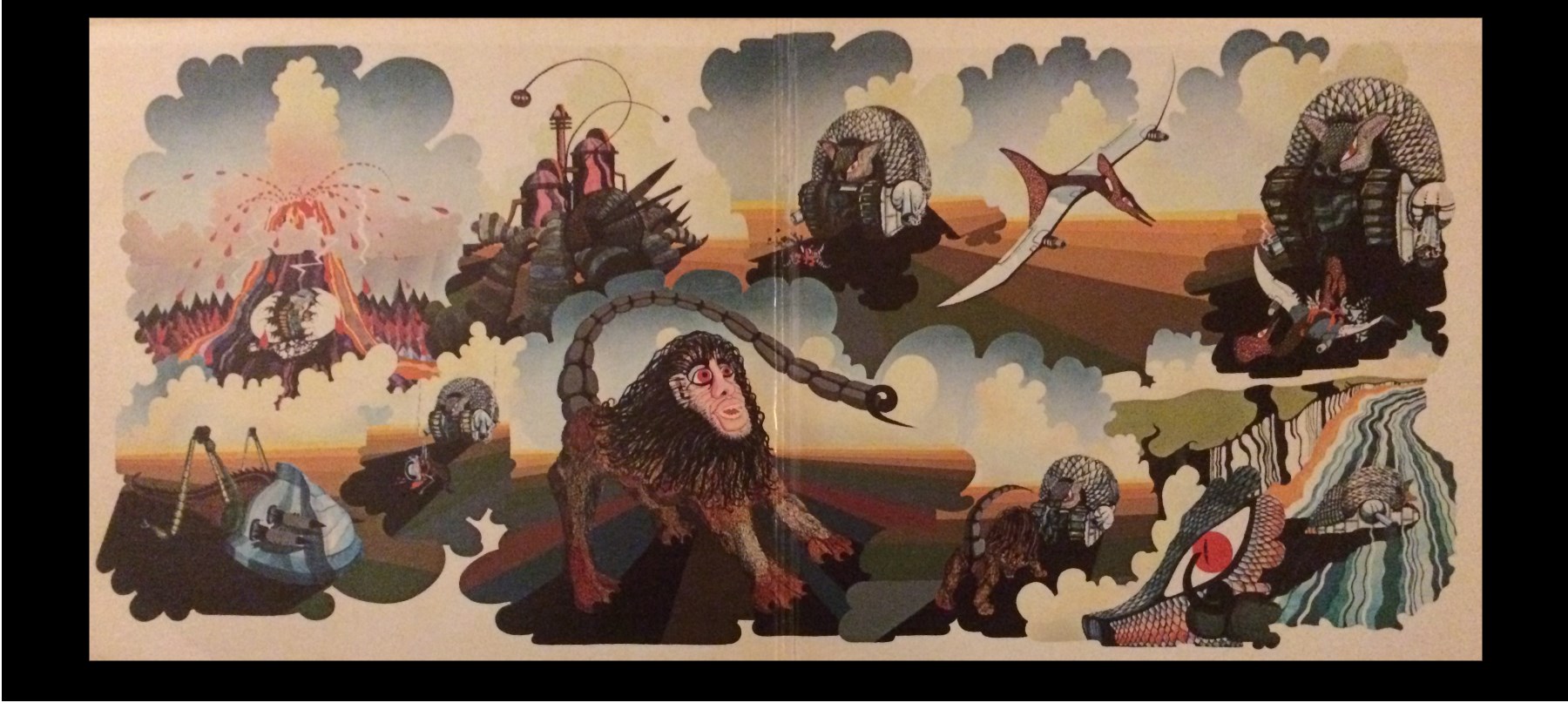Audio Program
Download
We remind you that the audio fragments embedded in the text are to be used when reading the article without listening to the audio program. All these examples are included in the audio program.
Welcome to the third edition of the Classic of the Month. Today: “Tarkus” by Emerson Lake & Palmer.
When we explored the secrets of Close to the Edge, we examined a piece with is a very tight connection between music and lyrics. Jon Anderson, main composer of the music together with Steve Howe, is also the author of the lyrics. Tarkus on the other hand, was a result of merging two parallel processes. Most of the music with the exception of “Battlefield” was written by Emerson while all the lyrics were written by Greg Lake.
It is a relatively well known fact that Tarkus initially generated friction between Emerson and Lake. According to Emerson:
Lake was finally convinced to give it a shot and the music gradually grew within him, to the point that he developed some of his finest lyrics and included a piece of his own.
As a result of these independent endeavors, Tarkus is quite self-sufficient as an abstract music piece. However, a full interpretation of the conceptual framework behind the piece allows a true rediscovery of this progressive rock masterpiece.
Tarkus is a multi-movement suite, where all the movements, except ”Stones of Years” and “Mass” share common melodic material. There are also other very interesting musical considerations but I will go back to them later in the analysis. Let’s concentrate on the conceptual framework which is what will truly allow us to listen to this piece under a very different light.
There have been different interpretations of what Tarkus represents. Edward Macan, in his book “Rocking the Classics” makes an accurate summary:
More than non-exclusive, I would say that they complement each other. In fact, here’s another interpretation based on my article “The Cult to the Ephemeral and its Effect on Art”: Tarkus could represent the entertainment society that is devouring culture, transforming it into mass entertainment.
The 11 images in the album’s inner gatefold, created by William Neal, are crucial to creating a framework through which the piece’s concept is conveyed.
The first image represents the opening section “Eruption”. It depicts Tarkus emerging from an egg on the side of an active volcano:
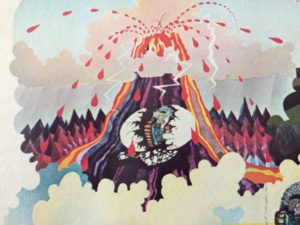
Notice that Tarkus is really a cybernetic creature, part armadillo and part tank:
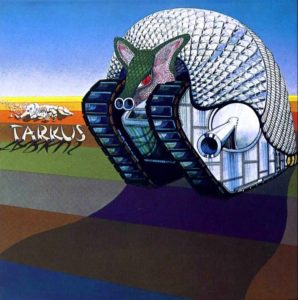
It fights, and claims victory, over different cybernetic animals:
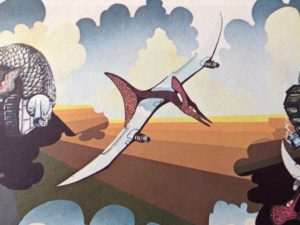
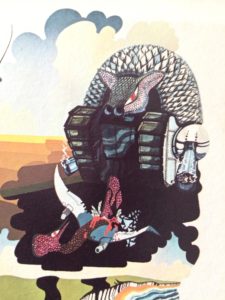
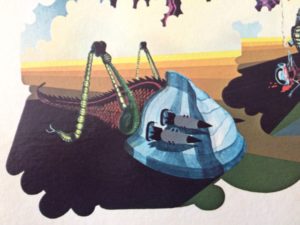
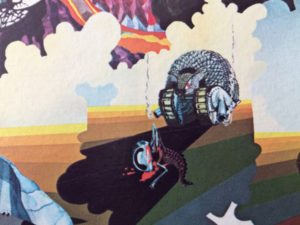
However it is defeated, at least temporarily, by the only creature that is completely biological, the “Manticore”.
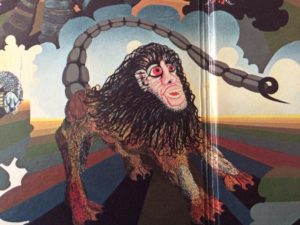
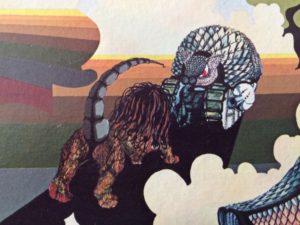
This strange figure, mixture of different animals (man, lion, scorpion, among others) is able to sting Tarkus’s left eye, forcing him to retreat.
The final panel is perfectly described by Edward Macan:
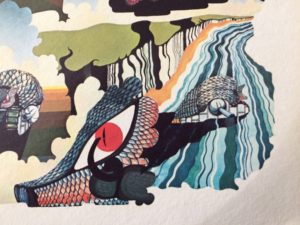
The whole suite revolves around this concept. As we will see, the lyrics reflect on the state of mankind and the struggle for human nature to prevail over the diverse forces that are slowly annihilating the sense of individuality in every human being. By the way, this struggle between man and machine is also represented in Karn Evil 9, which we will analyze in a future program.
It is no coincidence that the concepts behind “Close to the Edge” and “Tarkus” share many common views. CTTE is more spiritual and Tarkus more political, but they all point in the same direction: warning signs about where political, economic and technological forces can lead us to… Both pieces were written still under the influence of the psychedelic hippie movement; it was losing its grip on society in the early 70’s but still had a strong inertia.
Looking at the piece from a musical structure point of view, the first organizing principle is the juxtaposition of odd-numbered instrumental movements with even-numbered “song” movements. A second organizing principle has to do with the tempo. The first three instrumental sections are fast, whereas the first and third songs are slow – in line with the mournful character of the lyrics. The sharp and ironic lyrics of the second “song” are represented by a faster tempo. The final instrumental section combines a slow tempo – the funeral march – with the recapitulation of the sizzling opening theme.
From an overall perspective, Tarkus is organized following a nested structure:
Inst Fast – Song Slow – Inst Fast – Song Fast – Instr Fast- Song Slow – Instr Fast
So, starting from the middle movement – the only fast song (Mass) – the suite is symmetrical and begins and ends with the same material.
Now let’s look at each of the movements in more detail.
Eruption
The music in “Eruption” perfectly depicts the first scene. Its obsessive pattern in 5/4 gives a dynamic representation of what is going on: The rising pressure of the lava generated within the volcano, ends up spitting an egg out of which Tarkus emerges and runs down the hill to destroy everything at sight. One could claim that the lava represents the different forces – sociological, economic, technological – that have created this “entertainment society” devoid of spirit, cultural values, solidarity – who tries to find sense in life by way of a relentless mass consumption. The Tarkus.
The piece starts with a vocal effect. Lake recorded 20 different “ahhs” at different pitches, creating a volcanic mass that explodes into an ostinato figure. Fans with music knowledge frequently refer to this ostinato as a classic example of progressive rock using odd tempos, because the figure is written in 5/8. However, if you followed my explanation on music phrases in the analysis of “Close to the Edge”, you will see that the phrases that build up the melody rather suggest a 4+3+3 or a 4+6. So, this fragment of Tarkus is actually not an accurate example of a 5-beat rhythm. Let’s listen to it:
The form of “Eruption” is:
A – B – A’ – C – A” – C’ – Coda
Here are the beginnings of each section, so you can easily identify them:
The “A” sections are built with different variations of a bass ostinato. The use of ostinato bass figures became a trademark of Emerson’s music. Tarkus is an excellent example of his mastery in the use of this resource. It is introduced in “Eruption” but used in other sections of the suite. Here’s where you can find them in other movements:
Finally, it is interesting to point out that a rhythmic motif is used to relate the B and C sections.
In order to help you identify it, here’s a piano example. The bass note presents the figure and the treble note indicates the beats.
In section B, notice how it is used in the bass:
And then, by the organ, with a rhythm variation:
In section C, the pattern is used but in a compressed format:
And once again compressed, but this time adding two quarter note chords as a way to go back to the 5/4 pattern in A’’:
The Stones of Years
As Edward Macan points out, the lyrics of “The Stones of Years” can be summarized with the phrase:
“Tarkus has obliterated cultural tradition.”
“He speaks of time that has been ‘Overgrown, never known’, days that have ‘made you so unwise’”
With this insight, the lyrics are straightforward and require no interpretation:
Has the dawn ever seen your eyes?
Have the days made you so unwise
Realize, you are?
Had you talked to the winds of time,
Then you’d know how the waters rhyme,
Taste of wine,
How can you know where you’ve been?
In time you’ll see the sign
And realize your sin.
Will you know how the seed is sown?
All your time has been overgrown,
Never known.
Have you walked on the stones of years?
When you speak, is it you that hears?
Are your ears full?
You can’t hear anything at all.
The only matter left to interpretation is who are these lyrics addressed to. According to Peter Ford in his master’s thesis, the rhetorical questions in the lyrics are directed at the Tarkus. In my opinion, they are aimed at the listener.
The structure of the movement is:
A-inst-a-B-inst-A-inst-A-coda
I use the lowercase “a” because only 4 measures from “A” are used before entering section “B”. Each sung section is separated by instrumental passages that are based on the same bass pattern. It is interest to point out that this pattern is introduced in the coda of “Eruption”. Let’s listen to some fragments:
This “state of affairs” described in the lyrics is represented by a strange cybernetic artifact that seems to be a building that might very well represent mankind’s current situation:
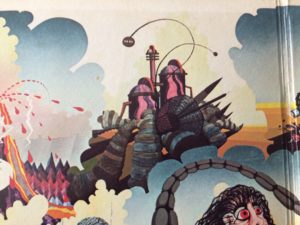
Tarkus doesn’t seem to find much trouble in destroying it. It is very small in comparison to him, and the music doesn’t portray a sense of battle, but rather despair.
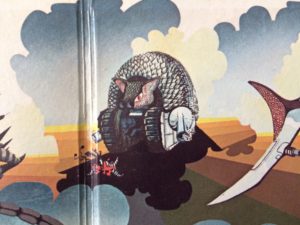
The second victim of “Tarkus” is a cybernetic pterosaur/warplane mutant called “Iconoclast”.
Iconoclast
This movement clearly shows the “Tarkus” in all its fury, as it goes about his business of destroying everything at sight. The ostinato figure presented in “Eruption” returns but in diminution (sixteenth notes) to convey the idea of a forceful and dynamic movement. Most of the movement is in 5/8 with intricate changes of tempo showing ELP’s performing abilities at its best.
The initial descending scale, in 2/2, represents the Iconoclast flying down to meet the Tarkus ….. and his defeat.
The form of “Iconoclast” falls into a large binary form. Part “A” includes the bass ostinato while “B” presents a more static bass with occasional ostinato appearing on Emerson’s right hand. Here’s my interpretation of what is going on: During part “A”, the Iconoclast is flying while fire and bullets are spit out of Tarkus’ fiery turrets. He runs at full speed to avoid the Iconoclast attack. Do you want to listen how Tarkus fires at the sky? Here it is:
And how the Iconoclast is shot and falls down to earth:
This event marks the end of part “A” and beginning of “B”. Now Tarkus runs to find where the Iconoclast has landed and stops in front of him. The iconoclast is in the ground, at his mercy. The ostinato figure stops – Tarkus moves in for the kill. The final measures with a breaking rhythm – short and long notes alternating in the bass, quite eloquently describe the final struggle before the Iconoclast is put to rest.
Mass
Although it may appear that the title refers to a Roman Catholic liturgical celebration, my interpretation of the lyrics is that Tarkus is destroying all forms of spiritual tradition. Religions turn into fanatic movements that defeat their own purpose: “The weaver in the web that he made”. Religion followers “committing every sin that they could”. The situation of the Middle East at the beginning of the 21st century is perfectly described with phrases like “minister of hate”, “messenger of fear”. Again, from this perspective, the lyrics require no further interpretation. They call forth some of Lake’s angriest and most imaginative lyrics:
The preacher said a prayer.
Save ev’ry single hair on his head.
He’s dead.
The minister of hate had just arrived too late to be spared.
Who cared?
The weaver in the web that he made!
The pilgrim wandered in,
Committing ev’ry sin that he could
So good…
The cardinal of grief was set in his belief he’d saved
From the grave
The weaver in the web that he made!
The high priest took a blade
To bless the ones that prayed,
And all obeyed.
The messenger of fear is slowly growing, nearer to the time,
A sign.
The weaver in the web that he made!
A bishops rings a bell,
A cloak of darkness fell across the ground
Without a sound!
The silent choir sing and in their silence,
Bring jaded sound, harmonic ground.
The weaver in the web that he made!
The form of Mass is very simple. There is no contrasting “B” section. All strophes use the same musical idea, with a tonal change in the last two. After the third strophe, there is a long instrumental section where tension is built gradually. It may very well represent the scene battle with the lizard/locust/missile launcher cybernetic creature depicted in the inner fold. It is also defeated by the Tarkus.
We finally reach the only fully biological creature, and the only one able to withstand the attack of the Tarkus: The Manticore.
Manticore
From a musical point of view, “Manticore” is very similar to “Iconoclast”. Themes are built around an ostinato, this time in a metric figure of 9/8. Again, strong syncopated sections seem to represent Tarkus firing at his enemy:
There is however, a significant deviation from previous instrumental movements: the rapid ostinato that represents the Tarkus, is suddenly stopped by fragments where the organ remains solo. The organ is presented under a rich sea of reverb, as if being played in an enormous cathedral. This might represent the spiritual or human aspect of the Manticore. Tarkus’ attacks are stopped by some sort of supernatural (mystic?) power. Let’s listen to the fragment with this interpretation:
The battle goes on and the drum solo in the end seems to signal the moment when Tarkus is stung in the eye and retreats. Note that the drum solo is preceded by the same syncopated sections that represent the attack, but this time it is the Manticore who is in control, whipping the Tarkus repeatedly with his tail until he hits the target – Tarkus’ only vulnerable spot: his eyes.
According to Peter Ford, the form of the Manticore is a six-part form with Coda. However, I believe it is better interpreted as a theme and variations with an interlude:
A – A’ – B – A’’ – A’’’ – A – Coda
Where A’ through A’’’ are variations on “A”. “B” is a short contrasting theme in the middle. At the end of the movement, the “A” theme is recapitulated and the coda is in the form of a drum solo.
Let’s listen to the movement and I will identify each section:
When the battle is over, the Manticore reflects on what has happened, as he watches the Tarkus flowing down the river, while blood pours from his left eye. He appears to be dead. But, is he?
Battlefield
Within the context of the suite, “Battlefield” appears to be a reflection, a sort of debriefing of the battle that has just ended. However, given the nature of the Tarkus, its annihilation should not produce the sense of bitterness portrayed in the lyrics. Lake, or rather, the Manticore, is clearly not singing to the defeated Tarkus. He would not tell him: “You talk of freedom, starving children fall”. Lake is clearly talking to the listener. Both Macan and Ford argue that “Battlefield” is a protest song related to Vietnam War. And I believe that they are correct. However, there is a phrase that is significant and links back to the conceptual framework of the piece:
Where the blades of grass and arrows rain
Then there’d be no sorrow, be no pain.
Quoting Macan:
This ties in nicely with the fact that the Manticore is the only non-cybernetic creature.
Here are the lyrics:
Clear the battlefield and let me see
All the profit from our victory.
You talk of freedom, starving children fall.
Are you deaf when you hear the season’s call?
Were you there to watch the earth be scorched?
Did you stand beside the spectral torch?
Know the leaves of sorrow turned their face,
Scattered on the ashes of disgrace.
Ev’ry blade is sharp; the arrows fly
Where the victims of your armies lie,
Where the blades of grass and arrows rain
Then there’d be no sorrow,
Be no pain.
Note:
There are different versions of the phrase “Where the blades of grass…..” posted in the Internet:
Where the blades of brass and arrows reign
Where the blades of brass and arrows rain
Where the blades of grass and arrows reign
Where the blades of grass and arrows rain
I’m using the latter in line with Edward Macan’s article. Obviously this is the only version where Macan’s interpretation makes sense.
The form of “Battlefield” is a simple strophic form, using almost identical music for each strophe:
Intro – A (verse 1) – A’ (verse 2) – instr solos (2) – A’’ (verse 3)
The harmonic structure of the solos, follow the same pattern of the verses.
The most interesting aspect from a musical point of view, is the anticipation of the “Aquatarkus” theme that appears between verses 1 and 2, before solos 1 and 2, and before verse 3.
Even though the music of “Battlefield” is credited to Lake, I strongly believe that some passages correspond to Emerson. Ford in his thesis also supports this theory. The complex harmony of the initial 7 measures carry the stylistic stamp of Emerson. Also, of course, the “Aquatarkus” theme corresponds to Emerson; not only because of stylistic reasons but also because the last movement “Aquatarkus”, is credited only to Emerson. I also invite you to listen to what the organ is doing while Lake is singing. I believe the harmonic embellishments also correspond to Emerson. So in addition to the lyrics, Lake is probably the author of the melody and the harmonic structure of each verse.
Let’s listen to the fragments that I believe correspond to Emerson:
Aquatarkus
The time signature, a simple 4/4, and the drum pattern, suggest a march. A “Funeral March” for Tarkus, who is forced to deal with the fact that he must now adapt to his new environment, a river. He becomes an “Aquatarkus”. The music effectively describes the “Aquatarkus” floating away, and like an agonic creature, he has sudden spams to try to recover its vitality:
The music starts to recede slowly, leaving only the snare drum. This depicts the Manticore watching as the “Aquatarkus” fades away in the distance. The snare drum keeps the mournful character of the piece.
We have stated all along that the Tarkus may not have been destroyed but was only temporarily disabled. The reason for this is by interpreting the last section of this movement: a straight recapitulation of “Eruption” indicates that the struggle is not over. Tarkus seems to come back but in what form? The last measures of the suite may give you a clue:
Resources
This analysis would not have been possible without the solid foundation laid by these two academic works:
“Rocking the Classics” by Edward Macan. Oxford University Press. 1997.
“The Compositional Style of Keith Emerson in Tarkus”. Master’s thesis presented to the School of Graduate Studies – Department of Music – Indiana State University. Peter T. Ford. August 1994.
If you have music theory knowledge and want to delve deeper in the harmonic, melodic, intervallic, modal and rhythmic world of Keith Emerson, I thoroughly recommend that you read Mr. Ford’s thesis.
All music examples have been taken from the Steven Wilson remix published in 2012. It is not better than the original, just different. It highlights details that were hidden or even omitted in the original mix. This box set is not easy to find at an affordable price. If you want it, drop me a line at contact@phaedrus.es and I will connect you to the right guy.
All the illustrations are taken from my personal copy of the Tarkus vinyl edition that I purchased around 1975.
Background music
The background music has been based on a selection of works by different Japanese bands:
- “Aurora” from the album “The Earth Explorer” by “The Earth Explorer“
- “Puyol” from the album “QUI” by “QUI“
- “Minamo Ni Tsuki” from the album “QUI” by “QUI“
- “Shadow Picture” from the album “Five Evolved from Nine” by “Ain Soph“
Here’s a link to the Tarkus score.
There is an excellent orchestral version of Tarkus. This video offers several movements of the suite:
There are several piano solo versions of Tarkus. This is my favorite, performed by Massimo Bucci:
YouTube link.

